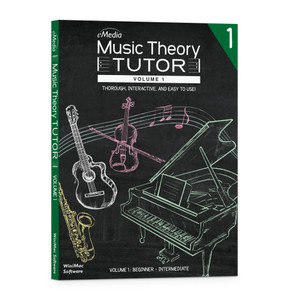
eMedia Music Theory Tutor Classroom License, 1- Computer, Teacher Presentation
eMediaContact for pricing
eMedia Music Theory Tutor Classroom License, 1- Computer, Teacher Presentation
Teaching Music Theory Just Got Easier With The Music Theory Tutor Classroom License!
The Music Theory Tutor Classroom License* is ideal for one-to-many instruction that uses one computer with large monitors, projectors and other presentation devices. It includes over 400 engaging lessons that teach the crucial musical elements of rhythm, melody, and harmony. Learning is easier and more effective with images, audio, interactivity, and numerous examples. An Intelligent Practice feature analyzes the student’s responses to questions and skill level and can even create an individualized practice program to improve their weak areas. Many lessons let the student enter pitches simply by humming, singing, or playing the student’s instrument into the computer’s microphone. The software listens as a student taps in rhythms, sings back pitches to guess intervals, and interacts with lessons. It is easy to see when pitches are correctly matched in a lesson, and you can view a chart of progress as you move through the course. Quizzes at the end of each subject and tests at the end of every grade level completion make it easy to assess progress.
The structured course and practice exercises help students to hear musical keys, scales, intervals, chords, and rhythms “in the their head” to read music more effectively compose without an instrument, improvise solos, and learn songs by ear faster.
"Well-thought-out music training application." - Softpedia
"This is a very, very cool tool for music teachers or any Mac user who wants to improve their singing or understanding of music."
- Mac360
"Ear Teacher offers a thoughtful, step-by-step introduction to ear training."
- Dr. Erik Steighner, saxophonist and music teacher
LEARN HOW MUSIC WORKS
Learn how rhythms, scales, chords, and chord progressions are created. Understand how tempos are described and notes are subdivided and grouped into measures. Learn the function of melody and harmony and how to use harmonic and rhythmic cadence. Understand all of the fundamentals that every composer, songwriter, and instrumentalist should know.
SEE THE MUSIC AND HEAR IT “INSIDE YOUR HEAD”
Students can learn to sight-sing music and hear it “in their head” by recognizing rhythms, intervals, and chord relationships.
TAP, HUM, SING and PLAY
Students can answer questions the natural way. Tap out the answer to a rhythm question; hum two notes to identify an interval, sing the notes in a melody, or play them on a musical instrument. Learning music shouldn’t be about typing!
ASSESS STUDENT PROGRESS
Students take tests and can view statistics to track progress. The Intelligent Practice feature tracks the student’s responses in lessons and automatically selects questions to improve weak spots.
Features:
- A step-by-step curriculum designed by Dr. Gregory Simon, who holds a doctorate in composition from the University of Michigan and teaches at the University of Colorado.
- Over 400 lessons, exercises, and tests with graphics, interactivity, and sound.
- Both music theory and basic ear training combined into one powerful application.
- A graph showing testing and answer statistics to lets you easily see progress.
- Intelligent Practice that tracks the student’s progress and automatically selects questions to improve weak spots.
- Exercises teaching rhythmic fundamentals including tempo, counting beats, measures, values for notes and rests, and syncopation
- Rhythmic lessons teach counting plus recognition of simple and compound time signatures (including 3/4, 4/4, 5/4, 6/4, 7/4, 3/8, 9/8, etc.) and cut time.
- Interactive lessons for learning how to read music with explanations and exercises for learning clefs, key signatures, note pitches, names, and rhythmic values (including dotted and beamed notes) including advanced triplets.
- Explanation of major, minor (harmonic and natural), and chromatic scale construction plus modes and the Circle of Fifths.
- Ear training and theory exercises help students to identify and understand note direction and motion, intervals (fourths, fifths, tritones, melodic/harmonic, etc.) scales, chords, and progressions.
- Melodic identification studies that cover note stability and resolution plus the roles of melody and harmony.
- Interval identification studies (fourths, fifths, tritones, melodic/harmonic, etc.).
- Chord theory lessons outline chord construction (major and minor triads, diminished, augmented, and 7ths), inversions, and arpeggios.
- Lessons on creating chord progressions covering chord positions and functions within progressions (tonic, dominant, subdominant, etc.), Roman numeral (I, IV, V, etc.) and figured bass notation, plus chord substitutions, phrasing, cadence, passing, and pedal tones.
- Lessons and exercises in musical form and analysis (binary, ternary, rondo, phrasing, etc.) help a student better understand composition.
- A harmonic flowchart plus major and minor harmony studies.
- Solfege studies with arpeggio and sight singing.
* This product is only to be purchased by and licensed to schools or institutions.
System Requirements:
Windows:
Windows XP, Vista, 7, 8, and 10
2.2GHz CPU, 2GB RAM
OpenGL-capable video card and driver
300 MB of hard drive space
Mac:
10.6 or later
2.2GHz CPU, 2GB RAM
300 MB of hard drive space





